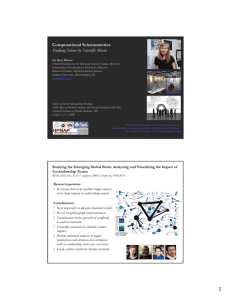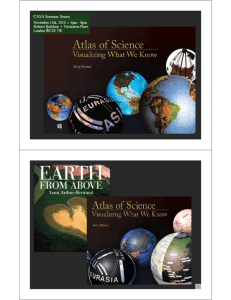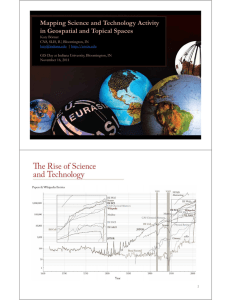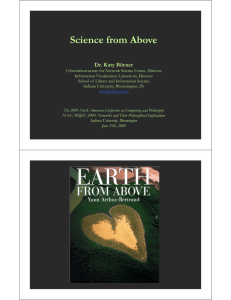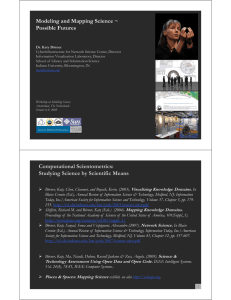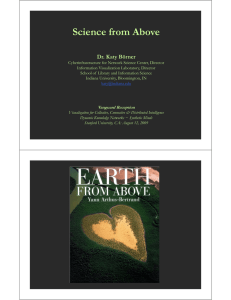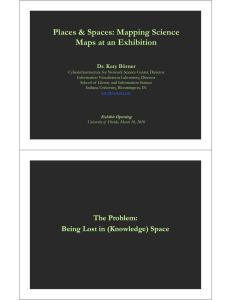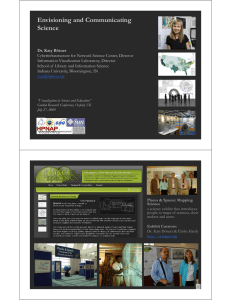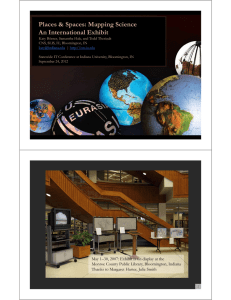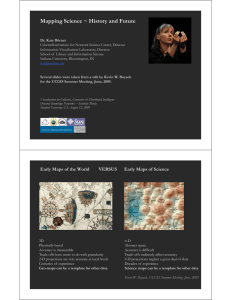Computational Scientometrics That Informs Science Policy
advertisement
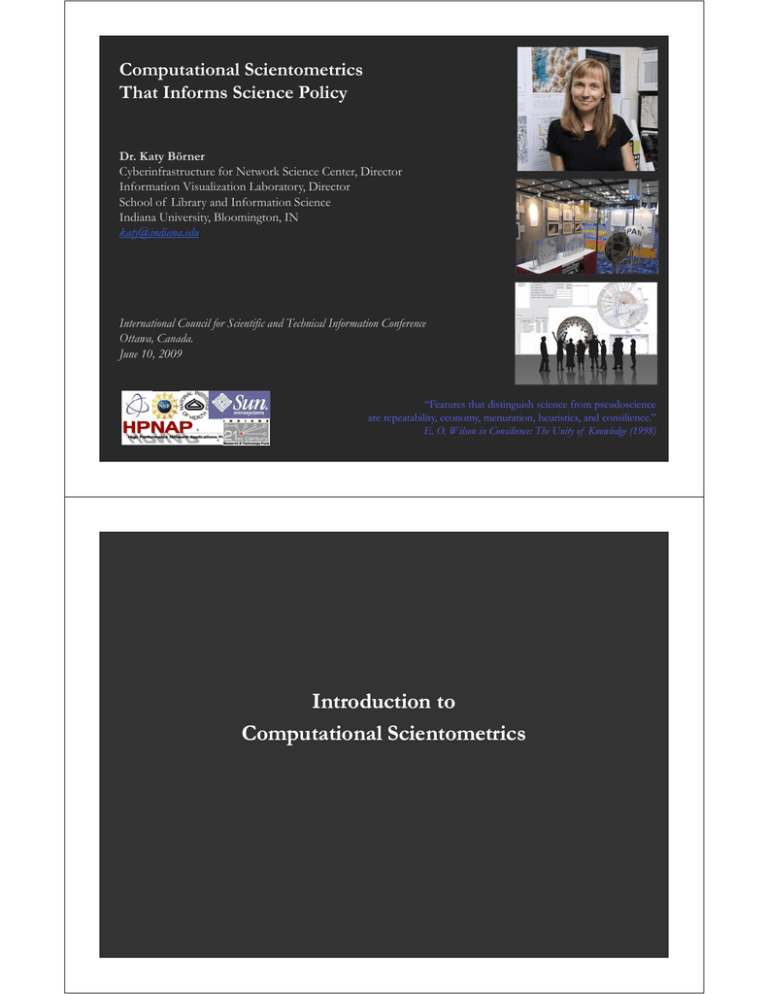
Computational Scientometrics That Informs Science Policy Dr. Katy Börner Dr Cyberinfrastructure for Network Science Center, Director Information Visualization Laboratory, Director School of Library and Information Science Indiana University University, Bloomington, Bloomington IN katy@indiana.edu International Council for Scientific and Technical Information Conference Ottawa Canada Ottawa, Canada. June 10, 2009 “Features that h ddistinguish h science ffrom pseudoscience d are repeatability, economy, menuration, heuristics, and consilience.” E. O. Wilson in Consilience: The Unity of Knowledge (1998) Introduction to Computational Scientometrics General Scientometrics Workflow , Topics Börner, Katy, Chen, Chaomei, and Boyack, Kevin. (2003) Visualizing Knowledge Domains. In Blaise Cronin (Ed.), Annual Review of Information Science & Technology, Volume 37, Medford, NJ: Information Today, Inc./American Society for Information Science and Technology Technology, chapter 55, pp pp. 179 179-255. 255 Katy Borner: Computational Scientometrics That Informs Science Policy 3 Computational p Scientometrics: Studying Science by Scientific Means Börner,, Katy, y, Chen,, Chaomei,, and Boyack, y , Kevin. (2003). ( ) Visualizing Knowledge Domains. In Blaise Cronin (Ed.), ARIST, Medford, NJ: Information Today, Inc./American Society for Information Science and Technology, Volume 37, Chapter 5, pp. 179-255. http://ivl slis indiana edu/km/pub/2003 borner arist pdf http://ivl.slis.indiana.edu/km/pub/2003-borner-arist.pdf Shiffrin, Richard M. and Börner, Katy (Eds.) (2004). Mapping Knowledge Domains. Proceedings of the National Academyy off Sciences off the United States off America,, 101(Suppl_1). http://www.pnas.org/content/vol101/suppl_1/ Börner, Katy, Sanyal, Soma and Vespignani, Alessandro (2007). Network Science. In Blaise Cronin (Ed.), ARIST, Information Today, Inc./American Society for Information Science and Technology, Medford, NJ, Volume 41, Chapter 12, pp. 537-607. http://ivl slis indiana edu/km/pub/2007 borner arist pdf http://ivl.slis.indiana.edu/km/pub/2007-borner-arist.pdf 4 Scientometrics Opportunities Advantages for Science Policy Makers/Funders Supports monitoring of (long-term) money flow and research developments, evaluation of fundingg strategies g for different p programs, g , decisions on p project j durations,, fundingg patterns. p Staff resources can be used for scientific program development, to identify areas for future development, and the stimulation of new research areas. Advantages for Researchers Easy access to research results, results relevant funding programs and their success rates, rates potential collaborators, competitors, related projects/publications (research push). More time for research and teaching. Advantages for Industry Fast and easy access to major results, experts, etc. Can influence the direction of research by entering information on needed technologies (industry-pull). Advantages Ad antages for Publishers P blishers Unique interface to their data. Publicly funded development of databases and their interlinkage. For Society Dramatically improved access to scientific knowledge and expertise. Katy Borner: Computational Scientometrics That Informs Science Policy 5 2002 ‘Base Map’ of Science Kevin W. Boyack, Katy Börner, & Richard Klavans (2007). Mapping the Structure and Evolution of Ch i Research. Chemistry R h 11th 11 h International I i l Conference C f on Scientometrics Si i andd Informetrics. I f i pp. 112-123. 112 123 Uses combined SCI/SSCI from 2002 • 1.07M papers, 24.5M references, 7,300 journals • Bibliographic coupling of p p r aggregated papers, r t d tto journals Initial ordination and clustering of journals gave 671 clusters Coupling counts were reaggregated at the journal cluster level to calculate the • (x,y) positions for each journal cluster • by association, (x,y) positions ii for f each h jjournall Math Law Policy Computer Tech Statistics Economics Education CompSci Vision Phys-Chem Chemistry Physics Psychology Brain Environment Psychiatry GeoScience MRI Biology BioMaterials BioChem Microbiology Pl t Plant Cancer Animal Disease & Treatments Virology Infectious Diseases 6 Science map applications: Identifying core competency Kevin W. Boyack, Katy Börner, & Richard Klavans (2007). Funding patterns of the US Department of Energy (DOE) Math Law Computer Tech Policy Statistics Economics CompSci Vision Education Phys-Chem Chemistry Physics Psychology Brain Environment GeoScience Psychiatry MRI Biology GI BioBi Materials BioChem Microbiology Plant Cancer Animal Virology Infectious Diseases 7 Science map applications: Identifying core competency Kevin W. Boyack, Katy Börner, & Richard Klavans (2007). Funding Patterns of the National Science Foundation (NSF) Math Law Computer Tech Policy Statistics Economics CompSci Vision Education Phys-Chem Chemistry Physics Psychology Brain Environment Psychiatry GeoScience MRI Biology GI BioBi Materials BioChem Microbiology Plant Cancer Animal Virology Infectious Diseases 8 Science map applications: Identifying core competency Kevin W. Boyack, Katy Börner, & Richard Klavans (2007). Funding Patterns of the National Institutes of Health (NIH) Math Law Computer Tech Policy Statistics Economics CompSci Vision Education Phys-Chem Chemistry Physics Psychology Brain Environment Psychiatry GeoScience MRI Biology GI BioBi Materials BioChem Microbiology Plant Cancer Animal Virology Infectious Diseases 9 What do Science Policy Makers want? Needs Analysis Reported are initial results of 34 interviews with science policy makers and researchers at • Division director level at national, state, and private foundations (10), • Program officer level (12) (12), • University campus level (8), and • Science policy makers from Europe and Asia (4). conducted d t d between b t Feb. F b 8th, 8th 2008 andd Oct. O t 2nd, 2 d 2008. 2008 Each interview comprised a 40 min, audio-taped, informal discussion on specific i f information i needs, d datasets d andd tools l currently l used, d andd on what h a 'd 'dream tool'l' might look and feel like. A pre-interview questionnaire was used to acquire demographics and a post-interview questionnaire recorded input on priorities. 11 Currently Used Datasets, Tools, and Hardware In the pre-interview questionnaire subjects were asked “What databases do you use?” • • • • • • • • • • • • • People databases such as agency internal PI & reviewer databases, human resources databases Publication databases such as WoS, Scopus; Dialogue (SCI, SSCI, Philosopher's Jadex), PUBmed/Pubmed Central, SciCit, IND, JStor, PsychInfo, Google scholar, agency/university libraryy journal j holdings g (online), ( ), ISI/OIG / databases,, RePEc Patent databases such as PATSTAT, EPO, WPTO, and aggregators such as PatentLens, PatSTAT Intellectual property Public Intellectual Property Resource by UC Davis, SparcIP Funding databases such as NIH IMPACT II, SPIRES, QVR-internal NIH; NSF’s EIS, Proposal andd A Awards d "PARS" "El "Electronic i JJacket, k IES A Awards d D Database, b USA USAspending.gov, di R Research.gov h Federal reports such as SRS S&E Indicators, OECD data and statistics, Federal Budget databases, National Academies reports, AAAS reports, National Research Council (NRC) reports Survey data Taulbee Survey of CS salaries, NSF Surveys, EuroStats Internal proprietary databases at NSF, NSF NIH, NIH DOE Science databases such as FAO, USDA, GeneBank, TAIR, NCBI Plant genome Web data typically accessed via Google search News, e.g., about federal budget decisions, Science Alerts from Science Magazine, Factiva, Technology Review, Science, Nature Expertise via stakeholder opinions, expert panels Management, trends, insights – from scientific societies, American Evaluation Association 12 Insight g Needs The pre-interview questionnaire asked “What would you most like to understand about the structure/evolution of science and why? why?” Responses can be grouped by Science Structure and Dynamics • • • • Growth of interdisciplinary areas around a scientific field. Global growth of a scientific field. The development p of disciplines p and specialties p ((subdisciplines). p ) how science is structured -- performers, funding sources, (international) collaborations. Grant size vs. productivity Impact • • • • Criteria for qquality. y Scientific and public p health impacts. p Conditions for excellent science, use of scientific cooperation. Return on investment / impact spread of research discovery / impact of scientists on others. Does funding centers create a higher yield of knowledge than individual grants? Feedback Cycles y • • • Linkages between S&E funding, educational and discovery outcomes, invention and technology development, economical and social benefit, at least generally applicable predictable system. The way institutional structures (funding/evaluation/career systems/agenda setting) influence the dynamics of science. U d Understanding di the h iinnovation i cycle. l L Looking ki at hi history and d id identifying if i kkey technologies, h l i surveying i best practices for use today. Answer the question--"How best to foster innovation"? 13 Insights g From Verbal Interviews Different policy makers have very different tasks/priorities Division directors Rely mostly on experts, quick data access Provide input to talks/testimonies, regulatory/legislator proposal reviews, advice/data C Compare US tto other th countries, t i identify id tif emerging i areas, determine d t i impact i t off a decision d i i on US innovation capacity, national security, health and longevity Program officers Relyy more on data Report to foundation, state, US tax payers Identify ‘targets of opportunity' global), fund/support wisely (local), show impact (local+global) University officials Rely more on (internal) data Make internal seed funding decisions, pool resources for major grant applications, attract the best students, get private/state support, offer best research climate/education. All see people and projects as major “unit of analysis”. 14 Insights g From Verbal Interviews Major j Task Types: yp Connect IP to companies, i proposals l to reviewers, i experts to workshops, kh students to programs, researchers to project teams, innovation seekers to solution providers. Impact and ROI Analysis Scientific and public (health) impacts. Real Time Monitoring Funding/results, trajectories of people, bursts. Longitudinal Studies Understand dynamics of and delays in science system. 15 Computational Scientometrics Cyberinfrastructure http://sci.slis.indiana.edu 17 Scholarly Database of 23 million scholarly records http://sdb.slis.indiana.edu Information Visualization Cyberinfrastructure http://iv.slis.indiana.edu Network Workbench Tool and Community Wiki *NEW* Scientometrics plugins http://nwb.slis.indiana.edu Epidemics Cyberinfrastructure http://epic.slis.indiana.edu/ p p 18 Scholarly Database: Web Interface Anybody can register for free at https://sdb.slis.indiana.edu https://sdb slis indiana edu to search the about 23 million records and download results as data dumps. In May 2009, SDB has over 170 registered users from academia, industry, and government from over 80 institutions and four continents. 19 Network Workbench Tool An empty shell filled with algorithm plugins will ultimately be ‘packaged’ as a SciPolicy’ branded tool. The Network Workbench (NWB) tool supports researchers, educators, and practitioners interested in the study of biomedical, biomedical social and behavioral science, physics, and other networks. In Mayy 2009, the tool provides p more 110 plugins that support the preprocessing, analysis, modeling, and visualization of networks. M More than h 40 off these h plugins l i can be applied or were specifically designed for S&T studies. It has been downloaded more than 18,000 times since Dec. 2006. http://nwb.slis.indiana.edu/ 20 See https://nwb.slis.indiana.edu/community July 1st, 2008 21 SciPolicy Studies - Using Open Data and Open Code 22 SciPolicy Studies - Using Open Data and Open Code Science map overlays of base knowledge and/or core competencies Funding portfolios of NSF investigators i ti t Mapping Science Exhibit Mapping Science Exhibit – 10 Iterations in 10 years http://scimaps.org/ The Power of Maps (2005) Science Maps for Economic Decision Makers (2008) The Power of Reference Systems (2006) Science Maps for Science Policy Makers (2009) Science Maps for Scholars (2010) Science Maps as Visual Interfaces to Digital Libraries (2011) Science Maps for Kids (2012) Science Forecasts (2013) The Power of Forecasts (2007) How to Lie with Science Maps (2014) Exhibit has been shown in 52 venues on four continents. Also at - NSF, 10th Floor, 4201 Wilson Boulevard, Arlington, VA. - Chinese Academy of Sciences, China, May 17-Nov. 15, 2008. - University of Alberta, Edmonton, Canada, Nov 10-Jan 31, 2009 - Center of Advanced European Studies and Research, Bonn, Germany, Dec. 11-19, 2008. 25 Debut of 5th Iteration of Mapping Science Exhibit at MEDIA X was on May 18, 2009 g Hall,, Stanford Universityy at Wallenberg http://mediax.stanford.edu http://scaleindependentthought.typepad.com/photos/scimaps 26 Death and Taxes 2009, by Jess Bachman Courtesy of http://www.wallstats.com Herr II, Bruce W., Gully Burns, David Newman, Edmund Talley. 2007. A Topic Map of NIH Grants 2007. Bloomington, IN. 27 28 Bollen, Johan, Herbert Van de Sompel, Aric Hagberg, Luis M.A. Bettencourt, Ryan Chute, Marko A. Rodriquez, Lyudmila Balakireva. 2008. A Clickstream Map of Science. 29 Council for Chemical Research. 2009. Chemical R&D Powers the U.S. Innovation Engine. Washington, DC. Courtesy of the Council for Chemical Research. 30 Illuminated Diagram Display W. Bradford Paley, Kevin W. Boyack, Richard Kalvans, and Katy Börner (2007) Mapping, Illuminating, and Interacting with Science. SIGGRAPH 2007. Questions: • Who is doingg research on what topic and where? • What is the ‘footprint’ of interdisciplinary research fields? • What impact have scientists? Contributions: g resolution • Interactive, high interface to access and make sense of data about scholarly activity. Large-scale, high resolution prints illuminated via projector or screen. Interactive touch panel. 31 Science Maps in “Expedition Expedition Zukunft” Zukunft science train visiting 62 cities in 7 months 12 coaches, 300 m long Opening was on April 23rd, 2009 by German Chancellor Merkel http://www.expedition-zukunft.de 32 Thi is This i the th only l mockup k in i this thi slide lid show. h E Everything hi else l iis available il bl today. d Katy Borner: Computational Scientometrics That Informs Science Policy 33 Papers, maps, cyberinfrastructures, talks, press are linked from http://cns.slis.indiana.edu 34
